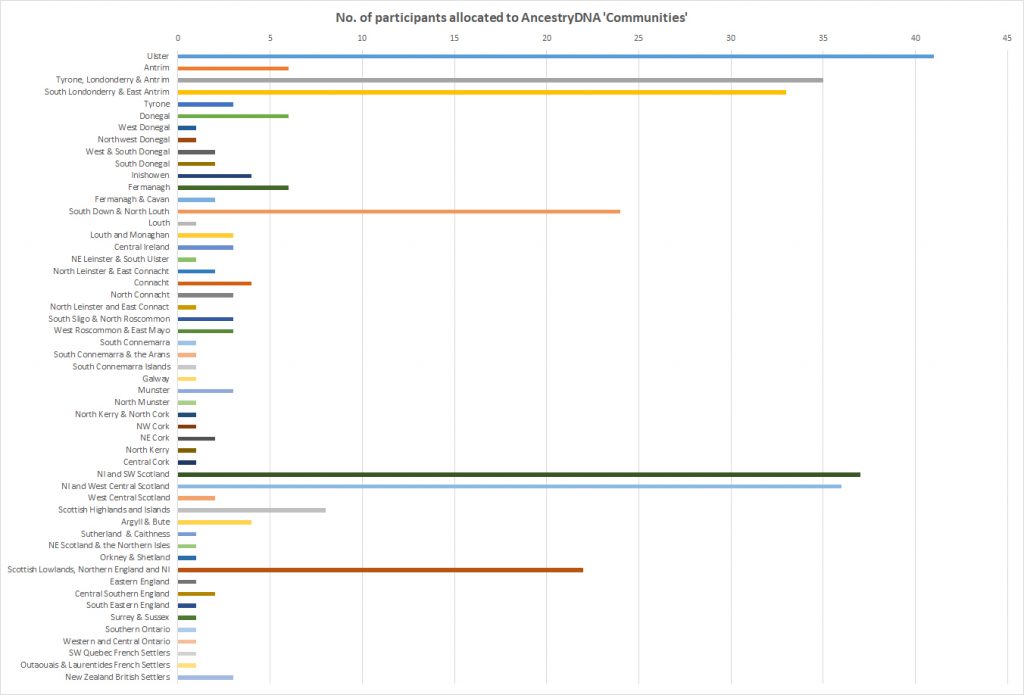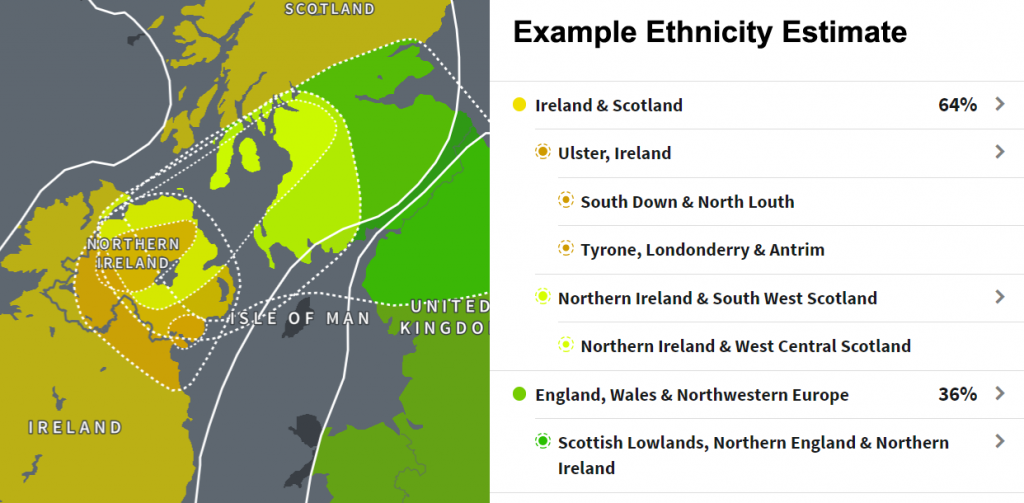Who do you think you are? Summary DNA results

Can you help us highlight the rich history of the Ould Lammas Fair?
18th August 2020
Who do you think you are? Speaking of identity…
25th August 2020Who do you think you are? Summary DNA results
Project Attributes
Project:
Owner:
Date:
25th August 2020
Who do you think you are?
Migration and identity in Rathlin, Ballycastle and the Glens
Over the course of Year 1 of the programme (2019-2020), 60 participants provided samples for DNA tests through the commercial testing company, AncestryDNA. In this post we are going to look at the summary results of the DNA testing based on the 45 participants who returned their DNA results prior to lockdown. Interspersed through the statistics are quotes recorded from the participants as part of the oral history element of the project.
“In terms of culture and identity, how do I normally see myself? I see myself part of the culture of the Glens of Antrim, that strong tradition of Gaelic culture. But I always was aware that, particularly Ballycastle, it is a very mixed area and we would have always been aware growing up about other traditions.”
It should be noted that the term ethnicity as employed by AncestryDNA should more accurately be described as genetic ancestry. Ethnicity is based on perception and has many layers which can be impacted by multiple factors including family background, language, religion, and community. The estimates provided by AncestryDNA are based on genetic markers of populations and do not necessarily correlate to identity or ethnicity.
“Well, I’m totally Irish and a little Scottish. Slightly disappointed, I thought there might have been a bit more European blood, but needless to mention, no, none.”
Genetic Ancestry
Forty-five participants returned results before lockdown. Of all of the ‘ethnicity’ estimates that were revealed, Irish/Scottish ancestry was the most common – millennia of population movement between the two regions has left a genetic signature that is difficult to untangle. All participants – even those not born or raised in on the island of Ireland or Scotland – showed DNA markers for Irish/Scottish ancestry ranging from 29-100%. Seventeen of our 45 respondents returned results of 100% Irish/Scottish, something which is, anecdotally, very rare.
“I see myself as Irish and I suppose, Scots-Irish because my mother was born in Scotland and I have a lot of Scottish relatives because they were all reared there … I have Scottish relatives up in the Highlands and whatever and I went to university in Scotland. I would see myself as Scots-Irish, I think, and Northern Irish.”
The second most common ancestry estimate was for England, Wales and NW Europe with ranges of 0% to 66%, referred to most commonly by participants as North-western European when recording their second interviews and discussing the test results.
Seven participants had trace Scandinavian ancestry (1-2%), five showing Norwegian, and two showing Swedish.
Two participants had distant ancestors from Germanic Europe (3%). One participant had trace ancestry from France (2%).
“Well, I have found out that as expected, I’m mostly Irish/Scottish, 97% according to the results. As I’ve said, I’m really delighted to have 3% of European Germanic … Well, that was a surprise very much because I had never heard of any connections with Europe.”
Taking our initial 45 participants as a representative sample of the population of Rathlin, Ballycastle and the Glens of Antrim, we find an unusually high level of genetic homogeneity with a genetic ancestry breakdown as follows:
-
Ireland and Scotland 91.24%
-
England, Wales and NW Europe 8.35%
-
Norway 1.8%
-
Germanic Europe 0.12%
-
Sweden 0.6%
-
France 0.4%
“I feel I’m always a native of this island and of this area and the family always has been Irish. I don’t feel particularly strongly nationalistic, but Irish.”
Communities
Within Ireland and Scotland however, there were a large variety of genetic communities represented, with participants with ancestors from the following ‘communities’ that AncestryDNA identifies from markers in a participant’s DNA. These communities are believed to show clusters of people with ancestors coming from a discrete geographic area.
-
Ulster;
-
Antrim;
-
Tyrone, Londonderry & Antrim;
-
South Londonderry & East Antrim;
-
Tyrone;
-
Donegal;
-
West Donegal;
-
Northwest Donegal;
-
West & South Donegal;
-
South Donegal;
-
Inishowen;
-
Fermanagh;
-
Fermanagh & Cavan;
-
South Down & North Louth;
-
Louth;
-
Louth and Monaghan;
-
Central Ireland;
-
NE Leinster & South Ulster;
-
North Leinster & East Connacht;
-
Connacht;
-
North Connacht;
-
North Leinster and East Connact;
-
South Sligo & North Roscommon;
-
West Roscommon & East Mayo;
-
South Connemarra;
-
South Connemarra & the Arans;
-
South Connemarra Islands;
-
Galway; Munster;
-
North Munster;
-
North Kerry & North Cork;
-
NW Cork;
-
NE Cork;
-
North Kerry;
-
Central Cork;
-
Northern Ireland and SW Scotland;
-
Northern Ireland and West Central Scotland;
-
West Central Scotland;
-
Scottish Highlands and Islands;
-
Argyll & Bute;
-
Sutherland & Caithness;
-
NE Scotland & the Northern Isles;
-
Orkney & Shetland;
-
Scottish Lowlands,
-
Northern England and Northern Ireland.
“… I’m Irish, or I come from the north of Ireland. When I lived in Scotland, I always said it was Northern Ireland I came from rather than Ireland because people then maybe thought it was Dublin or something like that. So, Northern Ireland.”
The Irish/Scottish communities with the highest representation among our 45 participants were: Ulster (37 individuals), Northern Ireland and SW Scotland, and Northern ireland and West Central Scotland (both with 33 individuals), Tyrone, Londonderry & Antrim (31), South Londonderry & East Antrim (30) and South Down & North Louth (23).

The high proportion of our participants returning results linked to South Down and North Louth (23/45, or 51%) is unusual, and no participants were aware of any specific family connections. These results may lead Ancestry DNA to consider shifting this genetic community further north, up to the Glens of Antrim.
“Well, according to the results, 100% Irish/Scottish which is not surprising, but there is some link, which I can’t make sense of, to down the east coast, what way was it described? Was it described as County Louth, it was down the east coast anyway … There was some connection according to [Ancestry] – but that doesn’t make any sense to me.”
Genetic communities outside of Ireland and Scotland were found in:
-
Eastern England;
-
Central Southern England;
-
South Eastern England;
-
Surrey & Sussex;
-
Southern Ontario;
-
Western and Central Ontario;
-
SW Quebec French Settlers;
-
Outaouais & Laurentides French Settlers;
-
New Zealand British Settlers.
All participants found family connections with people they knew, but did not realise they were related to, or had suspected family relationships confirmed.
All participants found many distant cousins around the world, principally in Canada, the United States, Australia and New Zealand – a legacy for the Irish diaspora.
“The initial number of cousins was 394, but after a couple of weeks, that’s increased to 398 … I think it is interesting, the sort of the multitude of relationships that have come down through the grandparents and through my own lines. Then obviously, all the siblings potentially of great, great, great grandparents. Some of those may have and would have been involved in migration, so that’s how it turns out I have relatives in Canada and Australia, America and England, etcetera. I think it will be interesting to follow that up.”
Find out more about this project by clicking on the links below
Project background
Summary DNA results
Speaking of identity…
Unknown family members and DNA colour clustering
The skeleton in the closet
The advantages of a geographic DNA project
Genealogical research training videos
PRONI introductory video
Collections care training videos
Moyle Migrations booklet
For more information, or to get involved with this or future projects, contact Museum Services at cms@causewaycoastandglens.gov.uk




